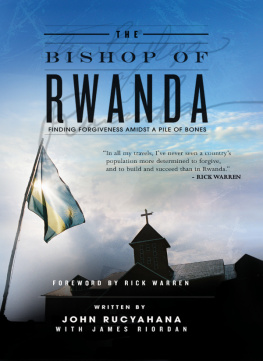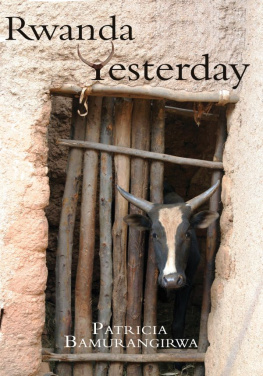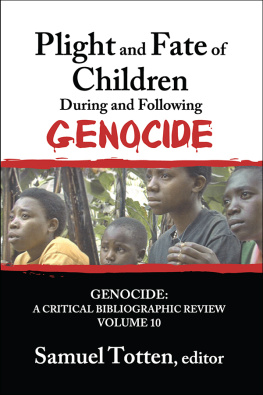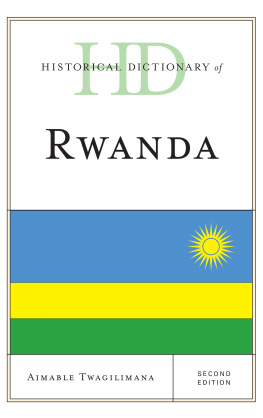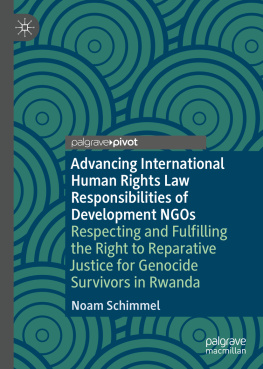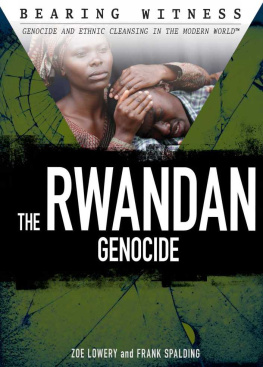University of California Press
Oakland, California
2020 by Donald E. Miller
Library of Congress Cataloging-in-Publication Data
Names: Miller, Donald E. (Donald Earl), 1946- author. | Miller, Lorna Touryan, contributor. | Miller, Arpi Misha, 1976- contributor.
Title: Becoming human again : an oral history of the Rwanda genocide against the Tutsi / Donald E. Miller, with Lorna Touryan Miller and Arpi Misha Miller.
Description: Oakland, California : University of California Press, [2020] | Includes bibliographical references and index.
Identifiers: LCCN 2019026629 (print) | LCCN 2019026630 (ebook) | ISBN 9780520343771 (cloth) | ISBN 9780520343788 (paperback) | ISBN 9780520975156 (ebook)
Subjects: LCSH : Genocide survivorsRwandaPsychological aspects. | Tutsi (African people)Crimes againstRwandaPsychological aspects. | WidowsRwandaHistory20th century. | Children and genocideRwandaHistory20th century. | RwandaHistoryCivil War, 1994.
Classification: LCC DT 450.435 . M 56 2020 (print) | LCC DT 450.435 (ebook) | DDC 967.57104/31dc23
LC record available at https://lccn.loc.gov/2019026629
LC ebook record available at https://lccn.loc.gov/2019026630
Manufactured in the United States of America
29 28 27 26 25 24 23 22 21 20
10 9 8 7 6 5 4 3 2 1
PREFACE
Like most things in life, this book has not progressed in a linear straight line. What began as an opportunity to speak at a conference in Rwanda about the Armenian genocide, the first genocide of the twentieth century, evolved into a love affair with a group of orphans in Rwanda. We had no intention of launching a new research project. Writing a book on the Armenian genocide had been challenging enough. However, sometimes things seem almost preordained to happen.
We had spent a number of summers in the commercial salmon fishing industry in Alaska, and after one of these seasons the owner of the company sent us a substantial check to be used for charitable purposes. Hence, when the orphans we met in Rwanda expressed an interest in doing an interview project with their members, all of whom were heading households of surviving brothers and sisters, the money was sitting in the bank, ready to fund their project. And a few years later, when an association of widows wanted to replicate the orphan project, it only took a single phone call to a foundation to secure funding for their project. At this point, there was no turning back. We had visited Rwanda a number of times, and the material emerging from these two projects was incredibly rich and compelling. We were hooked.
Making a strategic decision, Don decided to contact the John Templeton Foundation to see whether they might fund a new interview project, focusing on the issue of forgiveness, since this was a program area for the foundation. This time we would do the interviews ourselves; we decided to videotape them rather than simply record the interviews on audiotape, as had occurred in the previous two projects. Very rapidly we realized that survivors were not interested in talking about issues of forgiveness and reconciliation unless they could tell their story of what happened during the genocide. We also discovered that the hundred days of the genocide was only one element of their concerns. They wanted to describe the massacres and discrimination that Tutsis faced prior to 1994. And it was clear that the struggle for survival after the killing ended was also important. Consequently, our interview guide kept evolving as we did more and more interviews.
The richness and uniqueness of this book is that it is not just about the genocide, nor is it narrowly focused on forgiveness, which ended up getting only one chapter. We became convinced that it was important to tell a holistic story, locating forgiveness within the context of the killing, rape, and poverty that survivors experienced. This meant that it was also important to examine the themes of trauma and healing as well as the role of religion and the justice system. To ignore any of these elements would provide a simplistic account, since they interact together in the lives of survivors.
It is important to state up front that we have an anxiety about the way the book is structured. The accounts of the genocide in the first five chapters are excruciatingly painful and disturbing. Nevertheless, they are important to read because otherwise the more analytical chapters in the second half of the book are without context. But this is also the strength of the book: The fact that topics like healing, forgiveness, and justice are framed by the experience of survivors during the genocide.
While this book is focused specifically on the genocide against Tutsis, it is paradigmatic of other genocides and acts of mass violence, not only in the role of propaganda but also in the fact that the pain of genocide does not end with the killingit is ongoing, sometimes for generations and certainly for years as survivors struggle to heal from the trauma they experienced. Therefore, it is our hope that the thematic chapters of the book contribute to the academic literature on healing, religion, and justice from a grassroots perspective of the experience of common people. While we have cited some of the relevant source material on these topics, the book, fundamentally, draws its examples and insights directly from the survivors. The book is based on survivor testimony, grounded in their everyday experience, not what politicians, generals, and the international community were saying and doing.
In conclusion, it is important to say a few words about authorship. Lorna and Don conceived of this project together, visiting Rwanda many times over a fifteen-year period. Together we did all of the interviews at Solace Ministries. In 2006, our daughter, Arpi, joined us in Rwanda and experienced survivors and the country firsthand. After finishing her PhD in sociology at UCLA, she then became actively involved in reading and editing multiple drafts of the manuscript, bringing theoretical clarity to many of the chapters, and drafting some crucial takeaways. In this regard, it is a family effort. Lorna and Don spent hours coding each of the 260 interviews. Don wrote drafts of each chapter, which the three of us then critiqued, struggling for ways to order the material and illustrate the argument of each chapter by citing from our rich database of interviews. A colleague at USC, Professor Beth Meyerowitz, and one of her graduate students, Lauren Ng, worked with us about halfway through the project administering a survey on trauma and resilience to two of the populations that were interviewed for the book. Their analysis focuses on the issue of trauma and is presented in the second appendix.
The book has been gestating for a number of years. The core element is the interviews. The laborious work was coding every interview, line by line, after the interviews were translated from the local language of Kinyarwanda. It is the coding that made it possible to write a thematically ordered book. The insights for the book, however, are based on much more than interviews. Lorna and Don returned to Rwanda multiple times over a fifteen-year period, traveling around the country, sitting informally with survivors, visiting their homes, eating with survivors, going to memorial sites, attending the tenth and twentieth commemorations of the genocide, including accompanying conferences. In the acknowledgments, we mention the numerous people who have assisted us with the project, many of them becoming close friends, both orphans who are now grown and raising families and adult survivors who have inspired us at every point in our journey. While we chronical in this book the process of survivors regaining their humanity after the genocide, it is also true that after every trip to Rwanda, we felt more truly human. The superficial elements of life had been stripped away. The rudimentary fact of living interdependent lives searching for our common humanity had become primary.


